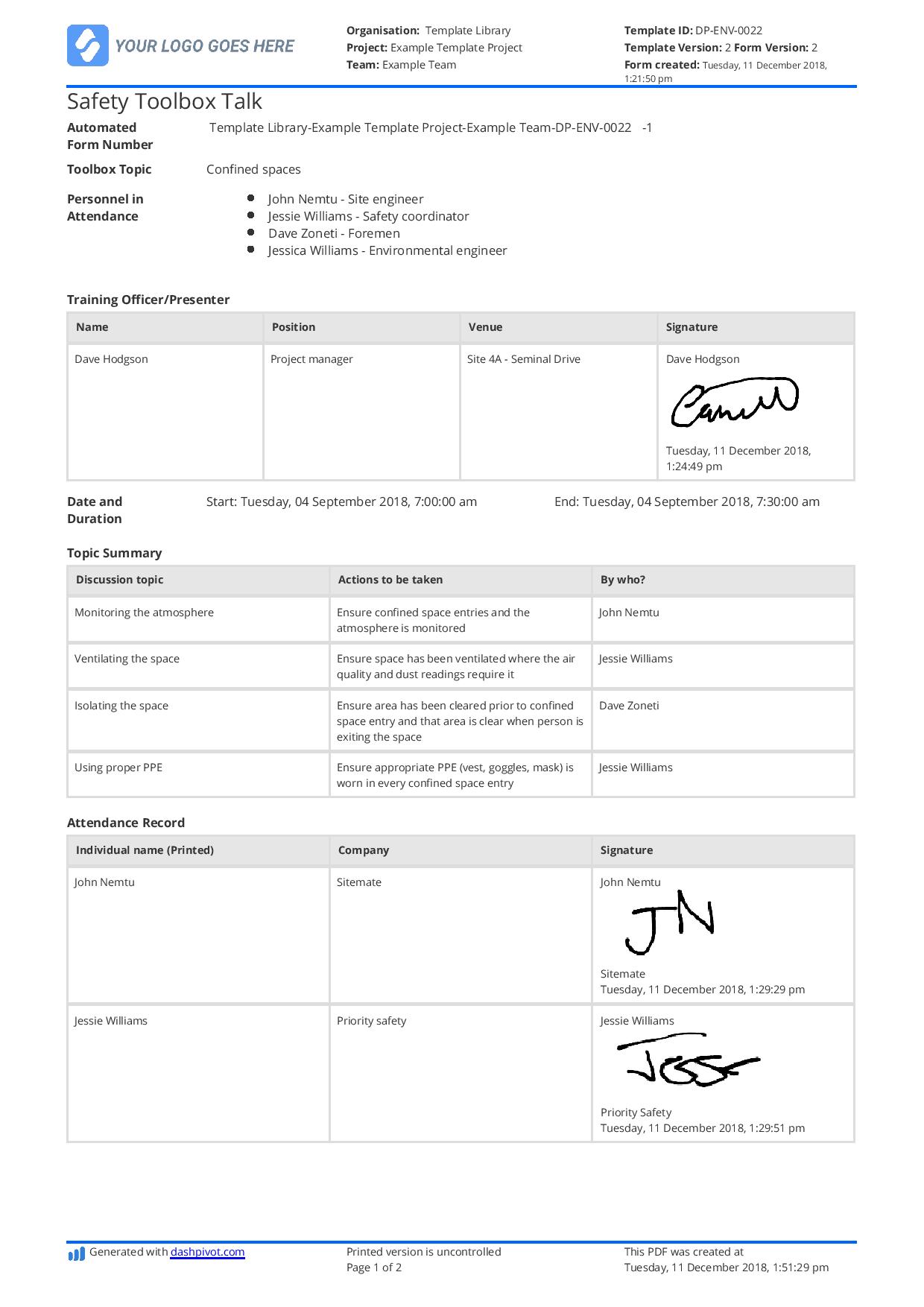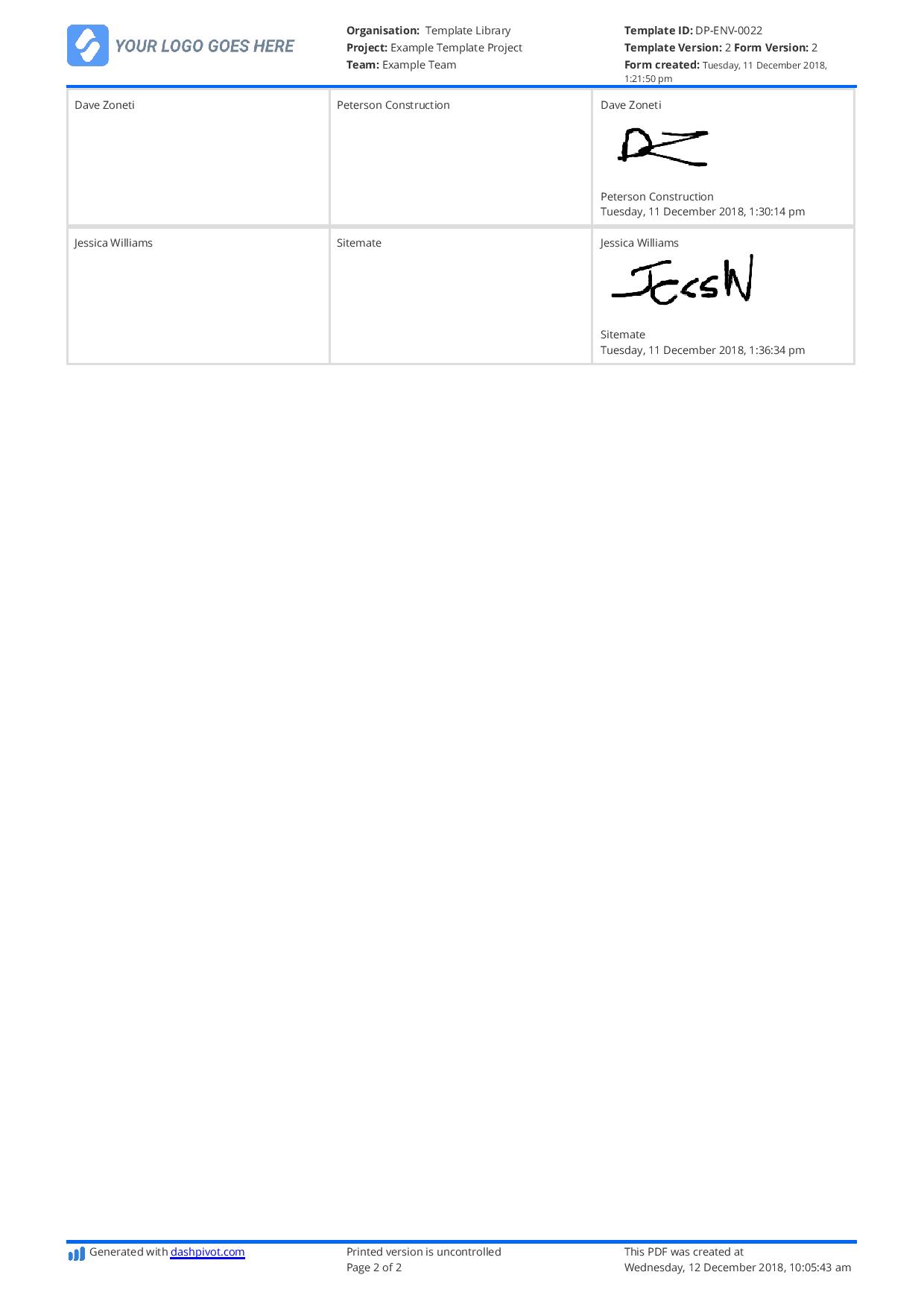Dashpivot article – toolbox talk ideas
Toolbox Talk Ideas
In this article, we will cover and explain the best toolbox talk ideas for people like you, so you can keep your toolboxes and safety briefing engaging and informative.

Toolbox talks are informal, short meetings that cover the daily activities in an organisation. Since they are informal, Toolbox meetings can be flexible in their structure and content. A kaleidoscope of ideas and topics can be inserted as long as it is relevant to the activity for the given day or keeps workers safe in the environment they are assigned in. Thinking of ideas can be a bit overwhelming since there is a lot to choose from, especially when you're really trying to make an impact on the safety culture of your organisation.
OSHA for toolbox talk ideas
The Occupational Safety and Health Association (OSHA) is an organisation that primarily focuses on ensuring safe and healthy working conditions. They are a regulatory body that checks if a certain organisation has followed the set of rules they have implemented and continues to develop and research ways they can still develop these rules to make the environment safer and healthier for workers.
These rules are globally accepted standards, although they do tend to be more focused on North America in general, which an organisation must follow.
Since these standards are vital to be followed, it would be beneficial for your team to be aware of them and practice them. The best way to share these standards is through your Toolbox talk sessions.
You can learn about whether toolbox talks are required by OSHA here.
You can look up standards from OSHA applicable to the processes in your organisation and present them to your team. Here are some OSHA standards examples you could use:
OSHA 1910.132 General Personal Protective Equipment
This section outlines the requirements for the use of personal protective equipment (PPE) in the workplace. It states that PPE must be provided, used, and maintained in a sanitary and reliable condition to protect employees from hazards of processes or environment, chemical hazards, radiological hazards, or mechanical irritants. In this section, it also states that employers are responsible for ensuring the adequacy of employee-owned equipment and ensuring its proper maintenance and sanitation.
OSHA 1910.39 Fire Prevention
OSHA standard requires that employers must have a fire prevention plan. The plan must be written, kept in the workplace, and available for review. The plan should include a list of major fire hazards, handling and storage procedures, potential ignition sources, fire protection equipment, flammable and combustible waste management, regular maintenance of safeguards, and employee information on fire hazards and fuel source control. Employers must also review the plan for self-protection with each employee upon initial job assignment.
OSHA 1910.144 Safety Color Codes for Marking Physical Hazards
This standard from OSHA provides specifics on the instructions on the colours to be used in marking physical hazards. This section outlines the use of red for fire protection equipment, danger signs, emergency stop bars on hazardous machines, and yellow for caution and physical hazards. Additionally, it requires that red is used for fire protection equipment, flammable liquid containers, and safety cans, while yellow is used for warning signs and stop buttons. Red lights are provided at barricades and temporary obstructions.
These are only a few examples of the sections from OSHA that are relevant for most industries. There are a lot of sections to choose from, and all you need to do is find the ones that are relevant to your processes.
Process Instructions for Toolbox Talk Ideas
These are documented instructions that are officially recognised by the company or organisation you are working with. These documents provide a detailed outline of certain procedures that are often done in your company to remove ambiguity amongst workers.These documents are also formal since sometimes they are used for regulatory purposes. The step-by-step procedure here and defining of roles can be used as a discussion for toolbox talks. These instructions are designed to have safe and efficient procedures, which could really maintain a good work output and keep workers safe and sound. Here are some examples of process instructions.
Toolbox Talk Ideas Around Operational Instructions
Operational instructions are usually related to the operation of vehicles and machines. They outline the pre-start-up procedures, the start-up procedures, the do's and don'ts when the machine is running, and the power shut-down procedures. The roles defined in this instruction are specific and must be filled and present during actual execution of procedures. This is to ensure that the machine is started, running, and shut-off properly. If done properly, it will maintain the safety of the operation and eliminate the possible hazards. Having said this, it is good to consider as one of the toolbox talk ideas.
Maintenance Instructions
The maintenance instruction is a procedural process for doing corrective maintenance on machines and equipment. Like operational instructions, the primary goal of this document is to remove ambiguity among workers. These instructions outline the preparatory procedures (e.g., permit to work and related documents, tools, and equipment needed for maintenance), LOTO procedures, required PPE for work, guidelines and step-by-step procedure for fixing the machine, and housekeeping and disposal procedures (essential for machines that contain hazardous chemicals). This will help in maintaining a safe environment before, during, and after maintenance works. It is highly recommended to include these instructions on the toolbox talks, especially when a certain maintenance activity is done regularly.
Machine Manual Instructions
These are usually included in newly bought equipment or machines. When machines are new and people still don't have the knowledge and skill to operate and maintain them, this manual could serve as a temporary reference for the instructions. Although not as detailed as the former 2 instructions, it will suffice since most of these manuals have already outlined the necessary safety measures in operating and maintaining the machine. This could also be a good reference to include in toolbox talks when introducing the new equipment or machine.
Relevant Events for Toolbox talk Ideas
Relevant events or news can immediately gain the interests of your co-workers. You can use this to your advantage by relating news and events to your toolbox meeting to spark the interest of your coworkers, then place a lesson to be learned when concluding the meeting.
Get Toolbox Talk Ideas from Recent Accidents
Recent accidents are the best toolbox talk idea. These events can provide a lot of information and lessons on what needs to be reinforced, the reason behind the accident, and what needs to be improved in the future. These talks can be engaging since this could be a platform to ask the workers about their opinion on the event. Like for example, You could ask them what needs to be done in order to avoid such an unwanted event. Another good question for you to ask during this talk would be: What safety measures can you recommend? Usually talks like these really leave an impression on the workers since they are really involved during the meeting. The accidents mentioned in this meeting do not limit themselves to the ones that happened within the company but also to the ones outside.
Toolbox Talk Ideas from Recent News in the Media
Recent news relevant to workplace safety can also be a good toolbox talk idea. A good example of these are fire outbreaks. Fires are usually reported on any news media platform, and details of them are explained. Just like accidents, you could use this report as an example and create an engaging toolbox session where you ask your listeners to participate and share their inputs on what could have been done to prevent such adversity. Engaging toolbox sessions are better remembered and foster a more open relationship between workers.
Physical And Mental Well-Being for Toolbox talk Ideas
A person's well-being is a huge factor in his work performance. It is important that organisations remind their employees that their healthy body is their capital to continuously earn money. They must inform and help employees understand how their health is relative to the company's output. One of the best ways to convey this message is through toolbox talks.
Mental Health Awareness Toolbox Talk Ideas
In the modern world, mental health awareness has been a growing effort to eliminate the stigma around mental illness and create ways to be able to have relevant healthcare for it. Mental health awareness in construction and previously massively 'masculine' industries are now accepting that talking about and tackling mental health is healthy.
A toolbox talk can be a safe space for your workers. You could help them understand some of these illnesses to help them be aware of the symptoms and have a grasp on what they can do to support the person who is suffering the illness. This will create a support system for the team and encourage them to openly talk if they have problems. Mental health is not a joke; it is something that people should sit down and talk about. It would be good to consider these kinds of talks with your workers.
Stress Management
According to the World Health Organisation, stress is a state of worry or mental tension caused by a difficult situation. It is a natural human response that prompts us to address challenges and threats in our lives. Stress is normal at work, but accumulating to much of it can be bad for your body and mental health. It is important that a person should regulate their stress levels. One way to help them do this is to have a platform to discuss what stressors can contribute greatly to a person's stress levels and how to regulate stress. One of the good platforms to discuss this is through toolbox talks. During these talks, you can ask your employees the kind of stressors they are dealing with and then discuss the ways to limit their exposure to them.
Physical Health Awareness
During toolbox discussions, you might talk about typical illnesses that workers may have and that a business should be aware of so that they can take precautions to avoid medical catastrophes. An excellent illustration of this is hypertension. You could talk about the significance of taking your prescriptions on a regular basis and the consequences of not doing so. You might also perform a brief physical examination and explain its significance. Employees will become more conscious of their health and feel more confident that the business is looking out for them as a result.

Use this Safety Toolbox Talk template for FREE
Another Smart Idea for Toolbox talks
While toolbox talks are informal, documenting them could still prove useful for organisations. In some regions, toolbox talks are even a legal requirement. But that leaves the question: How do I structure my toolbox talk to have all relevant information needed during the meeting.
The answer is simple: make a standard toolbox form. The form should contain the relevant topics and procedures, new concerns and issues, and signatures for those who attended the meeting. But we have come to understand that toolbox talks are flexible in their topics. It could change from day to day, depending on the relevant activity being done. The reformatting of the contents and printing it regularly is such a hassle. There is also the possibility of losing these papers, which would be a red flag for regions where toolbox talk documents are regulatory requirements.
Luckily, there is a platform called Dashpivot that digitises your forms and replaces the pen and paper process. Not only that, on this platform, there is a drag-and-drop form builder that gives you the freedom to personalise your concept and link it to the standard your organisation approves. This will also allow you to include sections and fields that are relevant to your toolbox talk topic. With this, it will remove the hassle of reformatting and printing the forms over and over again, which honestly takes a lot of time.
Take your toolbox talks anywhere you are comfortable. During the process of the toolbox talks and filling out the forms, it is not necessary to have an internet connection. On the Dashpivot platform, it is possible to fill out the forms while offline. You can just upload these forms when you get back to the office where there is a connection. By doing this, losing papers wouldn't be an issue anymore since on this platform, all your reports are automatically compiled. Also, and more importantly, you are literally doing Mother Earth a favour by consuming less paper.
With this, the flexibility of your toolbox talks wouldn't be a hindrance and a hassle to think about anymore since your form would also be as flexible. Check out this example of the digital form.
Looking for More Toolbox Talk Ideas?
Companies like Sitemate which provide software tools dedicated to improving how industrial companies manage their site records and compliance documentation also typically understand and can share best practices which have accumulated over tens of thousands of toolbox talks.
In fact, Sitemate has a library of hundreds of toolbox talk templates, which you can simply pull off the shelf (and customise) to save yourself having to come up with new toolbox talk ideas - whilst also ensuring you are covering safety to a high standard.

Heat stress toolbox talk idea
The best ideas are relevant ideas, use this toolbox if working in hot areas

Fatigue management toolbox
Highly topical, fatigue in the workplace is a good toolbox talk idea to cover

Extension cord safety
A great toolbox talk idea to cover extension cords, applicable to almost all workplaces
